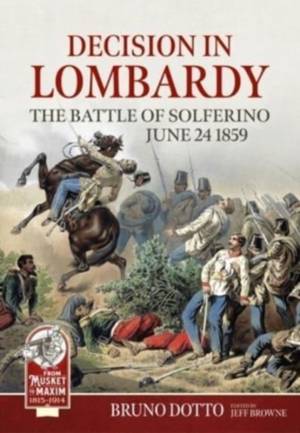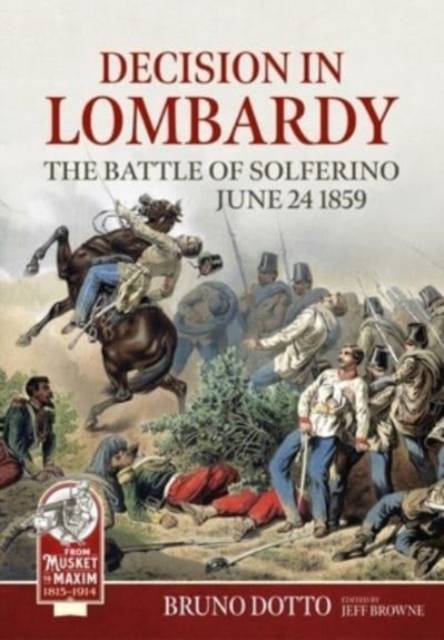
En raison d'une grêve chez bpost, votre commande pourrait être retardée. Vous avez besoin d’un livre rapidement ? Nos magasins vous accueillent à bras ouverts !
- Retrait gratuit dans votre magasin Club
- 7.000.000 titres dans notre catalogue
- Payer en toute sécurité
- Toujours un magasin près de chez vous
En raison de la grêve chez bpost, votre commande pourrait être retardée. Vous avez besoin d’un livre rapidement ? Nos magasins vous accueillent à bras ouverts !
- Retrait gratuit dans votre magasin Club
- 7.000.0000 titres dans notre catalogue
- Payer en toute sécurité
- Toujours un magasin près de chez vous
Description
Before dawn on June 24, 1859, near the small northern Italian town of Solferino, the largest battle on the European continent since the Napoleonic Wars was fought. The crucial encounter of the Second War of Italian Unification raged all day and into the evening, across an 18-kilometer front. This underappreciated battle featured nearly 300,000 men of all arms, led for the last time by their three sovereigns. Today, the Battle of Solferino-San Martino is known as the birthplace of the Red Cross, but the events of that day encapsulated much more. This work is translated from the original Italian and has been updated with new and never seen before maps and images. This work will inform historians, military enthusiasts and wargamers alike who will welcome the impressive detail of the combat between Austrian, French and Piedmontese armies.
This lucid and accurate analysis highlighting aspects never revealed before about events and people.
It describes in detail the long-range reconnaissance that led the Emperor of Austria Franz Joseph I to resume the offensive against the allied armies of France and the Kingdom of Sardinia. The deadly series of encounter battles that took place by the three belligerent armies in as many main sectors geographically delimited by the plateau of San Martino to the north, from the hilly strip of Solferino in the center and from the plain of Medole-Guidizzolo to the south were all carried out autonomously with little coordination.
The fight immediately ignited furiously first in Medole, then along the hilly ridge that from the Grole passes through Solferino arriving in Cavriana and beyond to Volta Mantovana.
All the individual clashes are analyzed, described and commented and some unpublished aspects revealed from the comparison of the reports of the commanders in suborder preserved in the State and War archives, with particular regard to the Austrian "Alte Feldakten" traced in the kilometer-long Viennese depots.
Finally, also a dutiful reconstruction of the events that saw protagonists in the imperial ranks the Venetian soldiers of the Wernhardt regiment, recruited in the districts of the provinces of Treviso and Venice, so far completely forgotten by history.
This lucid and accurate analysis highlighting aspects never revealed before about events and people.
It describes in detail the long-range reconnaissance that led the Emperor of Austria Franz Joseph I to resume the offensive against the allied armies of France and the Kingdom of Sardinia. The deadly series of encounter battles that took place by the three belligerent armies in as many main sectors geographically delimited by the plateau of San Martino to the north, from the hilly strip of Solferino in the center and from the plain of Medole-Guidizzolo to the south were all carried out autonomously with little coordination.
The fight immediately ignited furiously first in Medole, then along the hilly ridge that from the Grole passes through Solferino arriving in Cavriana and beyond to Volta Mantovana.
All the individual clashes are analyzed, described and commented and some unpublished aspects revealed from the comparison of the reports of the commanders in suborder preserved in the State and War archives, with particular regard to the Austrian "Alte Feldakten" traced in the kilometer-long Viennese depots.
Finally, also a dutiful reconstruction of the events that saw protagonists in the imperial ranks the Venetian soldiers of the Wernhardt regiment, recruited in the districts of the provinces of Treviso and Venice, so far completely forgotten by history.
Spécifications
Parties prenantes
- Auteur(s) :
- Editeur:
Contenu
- Nombre de pages :
- 500
- Langue:
- Anglais
- Collection :
Caractéristiques
- EAN:
- 9781804513330
- Date de parution :
- 31-08-25
- Format:
- Livre relié
- Format numérique:
- Genaaid
- Dimensions :
- 170 mm x 244 mm

Les avis
Nous publions uniquement les avis qui respectent les conditions requises. Consultez nos conditions pour les avis.






